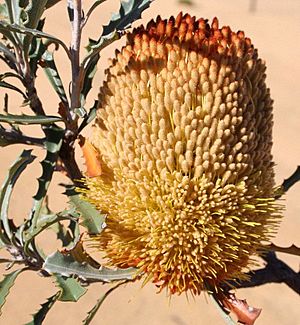Banksia ser. Ochraceae facts for kids
Quick facts for kids Banksia ser. Ochraceae |
|
|---|---|
 |
|
| B. audax, a member of B. ser. Ochraceae | |
| Scientific classification | |
| Kingdom: | |
| (unranked): | |
| (unranked): | |
| Order: | |
| Family: | |
| Genus: | |
| Subgenus: | |
| Series: |
Banksia ser. Ochraceae
K.R.Thiele
|
| Species | |
|
See text |
|
Banksia ser. Ochraceae is a scientific name for a group of plants within the plant genus Banksia. This group was first named by a scientist named Kevin Thiele in 1996. However, another scientist, Alex George, later decided not to use this name in his classification in 1999.
Contents
Understanding Plant Families (Cladistics)
Scientists use something called cladistics to figure out how different plants are related. It's like building a family tree for plants. In 1996, Kevin Thiele and Pauline Ladiges did a detailed study of Banksia plants.
They found that some groups of Banksia plants were not related in the way people thought. For example, a group called Banksia ser. Cyrtostylis was found to have plants that were not closely related to each other.
Thiele and Ladiges discovered that eight specific types of Banksia plants were very closely related. These eight plants formed two smaller groups, or "clades."
The Two Plant Groups
The first group included:
The second group included:
- B. benthamiana
- B. audax
- B. laevigata (which has two types: B. laevigata subsp. laevigata and B. laevigata subsp. fuscolutea)
Naming the New Group (Taxonomy)
Because these two groups of plants were so distinct, Thiele and Ladiges decided to give them their own series names. They kept the first group in B. ser. Cyrtostylis.
The second group was given a brand new name: B. ser. Ochraceae. The name comes from the Latin word ochraceae, which means "ochre-coloured." This refers to the brownish-orange colour of the flower spikes (called inflorescences) of most plants in this group.
They described the plants in B. ser. Ochraceae as having specific features. These included their long, thin pollen-presenters (part of the flower), very small early seedling leaves, and often brownish-orange flower spikes. B. benthamiana was chosen as the main example, or "type species," for this new series.
Where B. ser. Ochraceae Fits
In Thiele and Ladiges' system, B. ser. Ochraceae was placed within the larger group called B. subg. Banksia.
Here's a simplified look at where it was placed:
- Banksia
- B. subg. Banksia
- B. ser. Cyrtostylis (4 species)
- B. ser. Ochraceae
- B. benthamiana
- B. audax
- B. laevigata (with its two subspecies)
- B. subg. Banksia
However, this new way of organizing Banksia plants by Thiele and Ladiges was only used for a short time. In 1999, Alex George changed the classification again.
New Discoveries
Since 1998, another scientist named Austin Mast has been studying the DNA of Banksia plants. He uses DNA information to understand how plants are related.
Mast's studies have shown slightly different relationships compared to what Thiele and Ladiges found. For example, B. benthamiana and B. audax still seem closely related. But B. laevigata appears to be related in a different way.
In 2007, Mast and Thiele started to update the Banksia classification. They moved some plants from the Dryandra genus into Banksia. They also created a new subgenus called B. subg. Spathulatae for plants with spoon-shaped seedling leaves.
All the plants in B. ser. Ochraceae are part of Mast and Thiele's updated B. subg. Banksia. Scientists are still working on a complete new classification for all Banksia plants, especially as they finish studying the DNA of Dryandra species.
Images for kids



